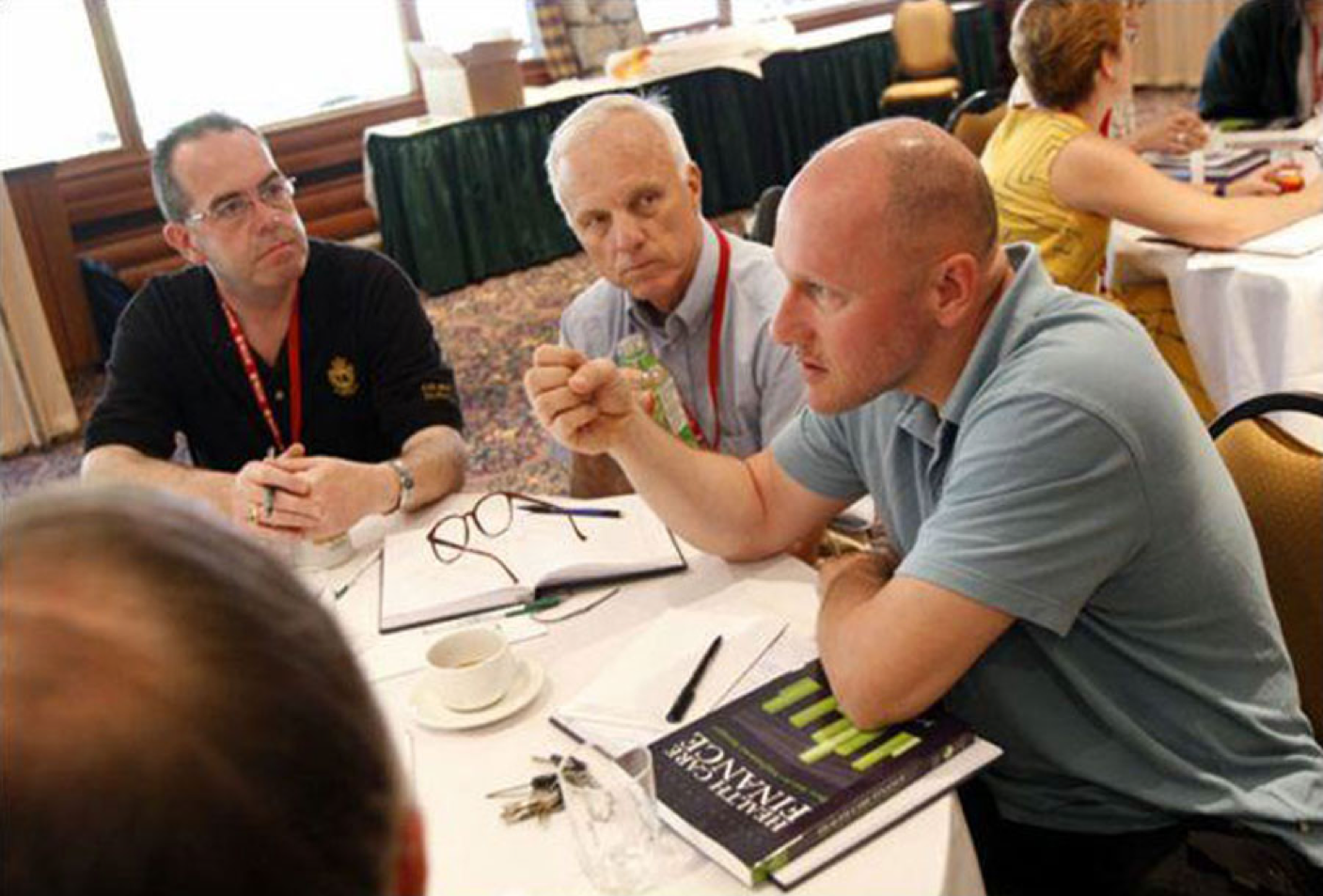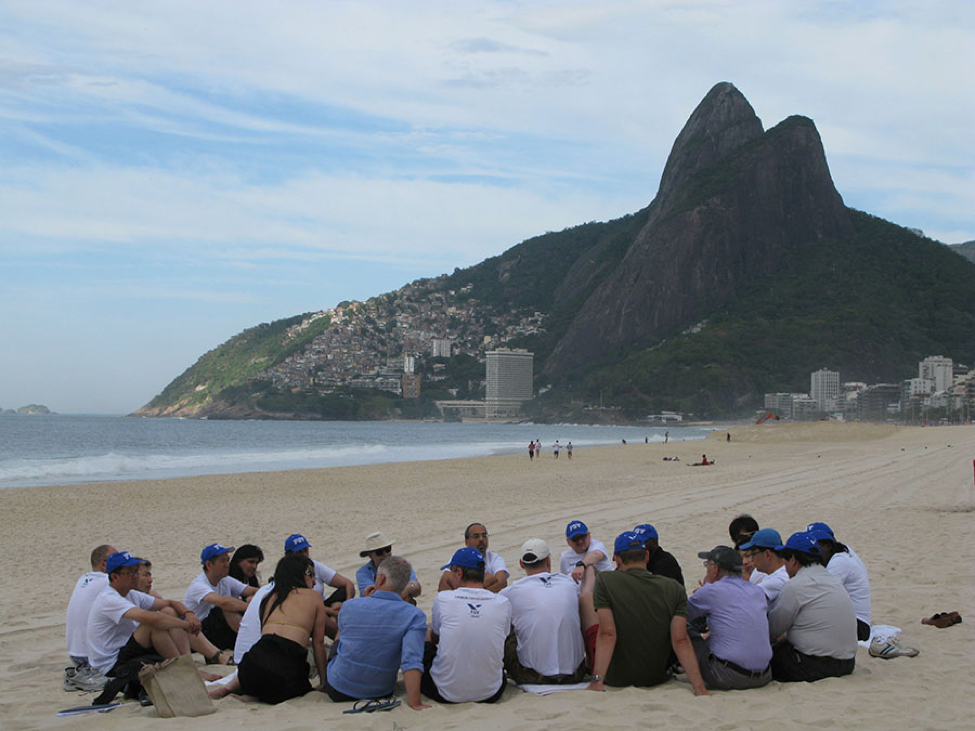Don’t just sit there…
4 May 2017Co-authored with Jonathan Gosling
Imagine a conference with a keynote listener instead of a keynote speaker. How about a meeting of the executive committee with the CEO facing backward, eavesdropping on the discussion but speechless until the end? Or picture a gathering of managers sitting in a circle to “show and tell” about their interests, just like they did in kindergarten.
Does all this sound like some other world? It could be yours. For years, we have had great success doing such things with managers in our programs. This began with our International Masters Program for Managers (impm.org), created to get past training about the business functions (the MBA), toward true education for managers. While a manager cannot be created in a classroom—this is the misconception of so many MBA programs—people who practice management can enhance their capabilities in a classroom that respects their experience.
The IMPM does things differently, starting with our 50:50 rule: faculty get half the class time to introduce ideas, but the other half is reserved for the managers to reflect on their own experience and share their insights with each other. In this program, which runs over 16 months, the managers come into our classrooms for five modules of 10 days, each one devoted to a managerial mindset, delivered by leading business schools around the world. (The reflective mindset takes place in Lancaster, England; the analytic mindset in Montreal, Canada; the worldly mindset in Bangalore, India; the collaborative mindset in Beijing, China; and the action mindset in Rio de Janeiro, Brazil.) Call this an emba if you like, so long as you realize that here it means engaging managers beyond administration.
“How are you going to seat them?” asked Nancy Badore, who had created a novel program for Ford executives and was helping us think through ours. “I suppose in one of those U-shaped classrooms?” one of us answered. “Not those obstetrics stirrups!” Nancy shot back. We got the point! With that, we were off—never looking back (except when the class asked us to face backward, to receive some feedback).
Nothing explains these differences better than the seating arrangements that we have established in the IMPM. These enable the managers to listen more attentively, speak more thoughtfully, and address their problems together more effectively.
Table Talk
Thanks to Nancy’s comment, we decided that the managers in our classrooms would sit at small round tables to facilitate learning from each other. No need to “break out” in some other place.

Round tables turn a collection of individual students into a community of engaged learners. (See Figures 1 and 2 at the end.) Managers bring wonderful experience to the classroom, so why not let them build on that with each other? So much better than pronouncing on cases that no-one in the room has experienced, or listening to theory without connecting it to their reality. We have a ritual starting every day in the IMPM, called morning reflections. It begins with everyone scribbling personal thoughts in his or her Insight Book (empty except for their own thoughts), followed by sharing their insights around the table, and then on to the plenary…
Show and Tell in a Big Circle
For these plenaries, we used to do what most programs do after workshops: ask for comments from each table—that dreadful go-around. Tell the teacher what was learned. Then one day, a new colleague put everyone in a big circle and sat down too. A great “show and tell” discussion followed. The next day, another colleague put them in the circle again but stood there, as if to say: I will give you permission to speak, and you will direct your comments to me, which I will follow with a smart reply. (Professors hate to stop professing.)
We had a photo of this, and so we whited him out. The next day, one of us repeated the circle, stood there too, and announced: “I’m in charge”—and promptly walked out. When he returned after the plenary, the class informed him that next time he was to take his place in the circle, like everyone else.

Eavesdropping
How about this? Instead of just discussion around each tables, followed by a big circle, turn around one person at each table, to eavesdrop without speaking, and then have these people report in the plenary on what they heard. Focused on listening, instead of waiting to speak, they hear a lot more of the nuance.
Here’s an example of using this eavesdropping. A colleague who was doing a session on managing retrenchment polled the class in advance as to who had positive, negative, and no experience with retrenchment. The positives sat at some tables and the negatives at others, to share their what they had learned about retrenchment. But what were we to do with the few who had no experience? Of course. have them eavesdrop at those tables! They all took profuse notes, and then…
The Inner Circle
…we brought these eavesdroppers together in the middle, facing each other in a little circle, to chat about what they heard, with the everyone else listening all around. (They became the eavesdroppers, about what they had just said!) Everyone loved this. One manager in the middle said that her group probably learned more about retrenchment than anyone else. Another, on the outside, said this was the best reporting out of a workshop that she had ever seen. The class dubbed the circle in the center “The Neutral Zone.”
Tapping In
Why stop here? After those in an inner circle have had their say, and some others are itching to add something, why not let them tap someone on the inside and replace him or her. The discussion carries on, in fact gets enlivened, still with the same number of people. Here we have something quite fascinating: a running conversation, with a few people at a time, yet everyone participating—listening intently and able to join, with no-one in charge. Once, when a journalist from the New York Times was in the class to write an article about the IMPM, we put him in the inner circle. Trouble was, everyone hesitated to tap him out! (See his article, “The Anti-MBA.”)
Keynote Listener
If we can have eavesdroppers at the tables, then why not in the whole class? One time, in another of our programs, we invited Marshal Ganz from the Harvard Kennedy School to do a session. He came early, to see what we were doing beforehand—presentations on some earlier work. So we designated Marshall to be the keynote listener, and comment on the presentations. Everyone, Marshall included, sat in a big circle as he discussed what he had heard. No canned speech, just honest reactions from a thoughtful listener.
Beyond the Classroom
OK, so all of this is well and good for a bunch of managers and professors having a good time while learning a lot in a classroom. But it hardly needs to stop there. We have used keynote listeners to replace keynote speakers in large conferences. We have used inner circles in rooms of 200 people, all sitting at round tables. After a presentation and workshop discussions around these tables, we said: “Quick, point to someone at your table who had a really good idea.” We invited the first few targets to come forward and share their ideas. One participant described this kind of exercise as a “great way to turn a large meeting into a series of meaningful conversations”—as well as one big conversation.
And into the Managerial Workplace
We have yet to turn the CEO of some major corporation around. (Maybe because they are too busy turning their companies around.) But imagine bringing all of this into the workplace: round tables, morning reflections, eavesdropping, taping, keynote listening, big circles and inner circles. Carlos Ramos was exposed to the seating in another of our programs (EMBA Roundtables), and when he got back home, installed a round table on the floor of his factory in Mexico City. Here is the picture he sent us, with the comment that “We use it very often” when there is the need to reflect on a difficult issue.

Coaching Ourselves
The two of us are part of another program, called CoachingOurselves.com, that dispenses with the professors and the classroom, but not the ideas. Managers gather together in their own workplace with a few of their peers or reports, and download slides on a particular topic (for example “Strategic Blindspots” or “Developing our Organization as a Community”). These they discuss with each other while relating the ideas to their common experience, to carry their insights forward to improve their organizations. In other words, change how and where managers sit, and suddenly management development can become organizational development!
As we mentioned earlier, you can experience all this for yourself. The next IMPM cohort begins in September (impm.org; for other innovations in the program, see “How about an emba that engages managers beyond administration”). Another version, in health care (imhl.org), begins its next class in April of 2018. The embaRoundtables.org, a one-week IMPM-type program for managers, runs every May (this year from May 1 in Dublin), and the McGill-HEC EMBA, modeled after the IMPM but with shorter modules in Montreal, runs from September every year.


 Morning reflections in our IMPM module in Rio de Janeiro.
Morning reflections in our IMPM module in Rio de Janeiro.
© Jonathan Gosling and Henry Mintzberg 2017; edited from an initial posting on this site on 1 July 2015.
Follow this TWOG on Twitter @mintzberg141, or receive the blogs directly in your inbox by subscribing here. To help disseminate these blogs, we also have a Facebook page and a LinkedIn page.